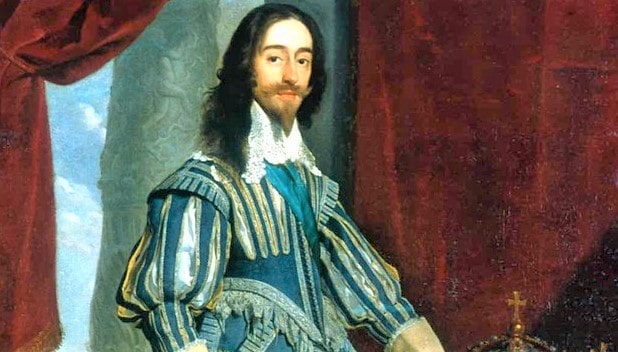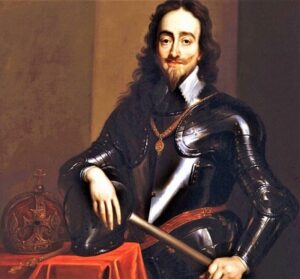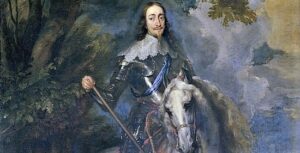
Charles I of England (Born on November 19, 1600, in Dunfermline – London, January 30, 1649) was The King of England, King of Scotland, and King of Ireland from 27 March 1625 until his execution in 1649. He is the only British monarch ever to be deposed and beheaded. He was the son of James I.
Charles I was born in the palace in Dunfermline, Scotland. His father was King of Scotland at the time, but not yet of England. The intended heir apparent was his elder brother Henry Frederick Stuart, the Prince of Wales. He died of typhus in 1612, making Charles heir to two thrones. In 1616 he became the Prince of Wales or the intended heir to the throne of England.
He was heavily influenced by his father’s favorite George Villiers, the first Earl of Buckingham. He took him to Spain in 1623 in search of a suitable bride. This was unsuccessful because the Spaniards demanded that Charles convert to Roman Catholicism.
The last years of Charles I was marked by the wars of the 3 Kingdoms and by the First English Revolution, during which he confronted the parliamentary forces. His troops were defeated in the First Civil War (1642-1645), Parliament expected that he would accept his demands for a constitutional monarchy, but he refused to negotiate, and forged an alliance with Scotland, before fleeing on the Isle of Wight.
This started a second civil war (1648-1649), and Charles I was beaten again, then arrested, tried, and executed for high treason. The monarchy was then abolished and a “Republic” called the Commonwealth of England was established, with Oliver Cromwell at its head.
Quick Facts: Charles I
- Born: 19 November 1600, Dunfermline Palace, Dunfermline, Scotland
- Also Known As: Charles I of England
- Known For: King of England, King of Scotland, and King of Ireland
- Reign: 27 March 1625 – 30 January 1649
- Parents: Father – James VI of Scotland and I of England, Mother – Anne of Denmark
- House: Stuart
- Religion: Anglican
- Spouse: Henrietta Maria of France (m. 1625)
- Died: 30 January 1649 (aged 48), Whitehall, London, England
- Burial: 9 February 1649, St George’s Chapel, Windsor Castle, England
The Early Life of Charles I
Charles I was born in Dunfermline Palace, the 19 of November of 1600, the second son of the nine male offspring of James VI of Scotland and I of England and Anne of Denmark. He was an underdeveloped child who was still unable to walk or speak at the age of 3.
When Queen Elizabeth I died in 1603 and James VI was proclaimed King of England as James I, Charles was left in Scotland under the care of nurses and servants because the journey was feared to harm his fragile health. Finally, he made the trip to England in July 1604.and was subsequently put in charge of Lady Carey, who taught him to walk and speak.

When he was an adult, he was 1m and 62cm. Charles I was not as well regarded as his older brother, Enrique Federico, Prince of Wales. Carlos himself adored his brother and tried to emulate him.
In 1605, as was then customary in the case of the second son of the English sovereign, Charles was appointed Duke of York in England. Two years earlier, in 1603, he had been named Duke of Albany in Scotland. When Henry died of typhus in 1612, Charles became the heir to the throne and was named Duke of Cornwall.
However, he was not named Prince of Wales and Earl of Chester, the usual titles of the heir to the English throne, until November 1616. Her sister Isabel married in 1613 with Federico V, Elector Palatine, leaving Charles virtually as an only child.
Marriage and children
King James, I died on March 27, 1625, then up Carlos to the throne as Charles I; on May 1, he married by proxy to Henriette Mary of France, who was still in Paris. His first Parliament, inaugurated by him in May, opposed his marriage to the French princess, a Catholic because they feared that Charles would lift restrictions on Catholics and undermine the official establishment of Protestantism.
Although he agreed with Parliament that he would not relax the restrictions regarding Catholics, he had promised to do exactly that in a secret treaty with his brother-in-law, King Louis XIII of France. The formal ceremony, with both present, was held at St. Augustine’s Church in Canterbury on June 13, 1625.
On February 2, 1626, Carlos was crowned in Westminster Abbey, but without his wife at his side, to avoid controversy.
From this marriage nine children were born:
- Charles James, Duke of Cornwall (March 13, 1629 – March 13, 1629)
- Charles II, King of England, Scotland and Ireland (May 29, 1630 – February 6, 1685)
- Maria Henrietta, later wife of William II, Prince of Orange (November 4, 1631 – December 24, 1660)
- James, as James II king of England and Ireland, as James VII king of Scotland (October 14, 1633 – September 6, 1701)
- Elizabeth Stuart (December 29, 1635 – September 8, 1650)
- Anne (March 17, 1637 – December 8, 1640)
The Regin of Charles I
Charles succeeded his father on March 27, 1625 as Charles I, King of England, Scotland, and Ireland on the throne. As early as April 9, 1625, he called a commission under the Duke of Buckingham to advise on the country’s foreign policy.
The key points were the relationship with Spain, an alliance with France and ways to restore the Palatinate, possibly with Dutch help. At least the alliance with France came to a big step closer in May 1625.
Karl married Henriette Marie de Bourbon, the Catholic daughter of the French King Henry IV and Maria de ‘Medici, on June 13, 1625, the coronation of Charles I finally took place on February 2, 1626, in Westminster Abbey.

England’s foreign policy was now much more aggressive, and the war with Spain broke out. Karl supported the Protestant Union under Christian IV of Denmark against the emperor with £ 30,000 and placed the Mansfeld troops under the United Provinces so that they could liberate the Electoral Palatinate in the war against Spain.
At the end of April 1625, Karl instructed the Admiralty to issue letters of correspondence that allowed the Spaniards to be attacked. On September 18, 1625, the Southampton Treaty was concluded with the United Provinces.
In it, both sides committed to a joint expedition against Spain. Finally, in October 1625, England sent an expedition fleet under Lord Edward Cecil of Spain. The English raided the port city of Cadiz, but after the arrival of Spanish relief workers on November 14, they retreated, leading to serious losses.
In 1627, the Duke of Buckingham followed a Huguenot cry for help from La Rochelle and engaged the English forces in a war against the French crown.
The English Revolution
The English Revolution had not yet started, but both sides began to arm themselves. After meaningless negotiations, Charles raised the royal banner (an anachronistic medieval gesture ) at Nottingham on August 22, 1642.
He then installed his court at Oxford, from where he had control over the north and west of England, while the parliament had control of London and the south and east of the country. Carlos raised the army using the archaic method of the Arsenal Commission.
The English Civil War began on October 25, 1642, with the Battle of Edgehill-which was unfinished- and continued indecisively between 1643 and 1644, until the Battle of Naseby tipped the military balance decisively in favor of Parliament.
A large number of defeats followed for the royalists, which ended with the siege of Oxford, from where Carlos managed to escape in April 1646. He then turned himself into the Scottish Presbyterian Army in Newark and was taken to the nearby town of Southwell, while his “hosts” decided what to do with him.
The Presbyterians finally reached an agreement with Parliament and handed Carlos over to him in 1647. He was imprisoned at Holdenby House in Northamptonshire until bugler George Joyce forcibly took him to Newmarket on behalf of the New Model Army. At the time, mutual suspicion had been unleashed between the New Model Army and Parliament, and Carlos was eager to exploit it in his favor.
Charles was then transferred to Oatlands and then to Hampton Court, where he was involved in new negotiations in a personal capacity but equally unsuccessful. They persuaded him that it would be better for him to escape – perhaps abroad, to France where his wife was, or perhaps in the custody of Robert Hammond, parliamentary governor of the Isle of Wight.
Charles decided on the last option, believing that Hammond was a realist, and fled on November 11. Hammond, however, betrayed the king and confined him to Carisbrooke Castle. From Carisbrooke, Charles continued to try to bargain with the different parties to avoid a tragic end, and eventually entered into negotiations with the Scottish Presbyterians, accepting the establishment of Presbyterianism in both England and Scotland for a trial period.
The royalists rose in arms in July 1648, and the Scots invaded the country, beginning the so-called Second Civil War. Defeated the Scottish armies, however, a few months later, and the final defeat for Carlos arrives at the Battle of Preston (17 to 19 of August of 1648).
Execution of Charles I
They captured Charles I and forced Parliament to accuse him of treason. A High Court of Justice was set up specifically for this purpose. Of the 135 members of this tribunal, many refused to do so or did not appear for the negotiations.
Only 68 members participated in the process that began on January 20, 1649 in Westminster Hall. On January 26, Karl was sentenced to death, and 59 members of the High Court signed the verdict.
Charles I was beheaded in front of the Banqueting House in London on January 30, 1649. On February 7, 1649, he was in the St. George’s Chapel of Windsor Castle in Berkshire buried. Here he rests next to Henry VIII. A few weeks later, the House of Commons declared England a republic.
It was ruled by Oliver Cromwell under the title of Lord Protector until he died in 1658. Two years later, under Charles I’s son, Charles II, the Stuart kingdom was restored.